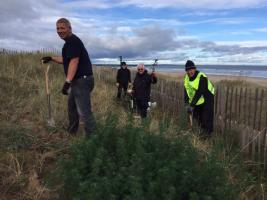A Brief History of Rolls Royce - the first 80 years
Tue, May 10th 2022 at 7:00 pm - 9:00 pm
Host - Stephen Bennie;
Reception - Wilda McKinnon;
Menu Choice - Graham Simpson
Club members please log in for more information.
Strathkinness resident Jim Tebbs gave a fascinating talk about the history of Rolls-Royce.
Jim, a former global business manager with
Rolls-Royce, joined the engineering company in 1967 and retired in 2007. He
then went on to join the Rolls-Royce Heritage Trust which was formed to promote
and preserve the history and engineering excellence of the company.
Jim said Henry Royce and Charles Rolls met in
Manchester in 1904. Both men had French cars which they were not entirely happy
with and Royce, as an “improving engineer,” produced a 10hp car which impressed
Mr Rolls.
The pair formalised their partnership in 1906
forming the Rolls-Royce company which then moved to Derby and Rolls said he
would sell as many vehicles Royce could make. By 1908 the luxury Rolls-Royce
Silver Ghost was in full production with Charles Rolls marketing the vehicle in
the US.
Rolls resigned from them company in 1909 to pursue
his interest in flying and was to die the following year in a Wright Bros biplane
crash at an air pageant in Bournemouth.
The famous Rolls-Royce car emblem, the Spirit of
Ecstasy, modelled by Charles Sykes, came into being in 1910.
The Eagle was the first aircraft engine to be
developed by Rolls-Royce Ltd. It was introduced in 1915 to meet the British
military requirements during the First World War. The company went on to become
a world leader in aircraft engines and employed two famous engineering greats,
R.J. Mitchell and Frank Whittle.
Royce died in 1933 but the company thrived and
after the Second World War as demand for travel grew the firm produced turbo
prop, turbo jet and turbo fan engines.
A nuclear power division was established in 1960.
However, the company’s fortunes dived and the firm
went into receivership in 1971. It was rescued with government aid but in 1973
the car division was demerged.
Rolls-Royce Motor Cars was later sold to
Volkswagen although BMW held the rights to the name and BMW took over
responsibility for Rolls-Royce cars in 2003.
Jim said Rolls-Royce’s latest 6-axial stage
turbine engine, with a 2.85 metre diameter intake fan, produced an incredible
100,000 thrust.
Jim outlined the strict testing for new engines
which could take years to gain accreditation. Engines needed to pass tests for
extended running, bird and water ingestion, cold starts and blade destruction.
Customer demands have now led to better fuel
efficiency, noise and emission reduction and improved serviceability.
Proposing a vote of thanks, club member Stephen
Bennie said Jim’s passion for engineering and Rolls-Royce shone through in his
excellent illustrated presentation.
'What We Do' Main Pages:
.jpg)







